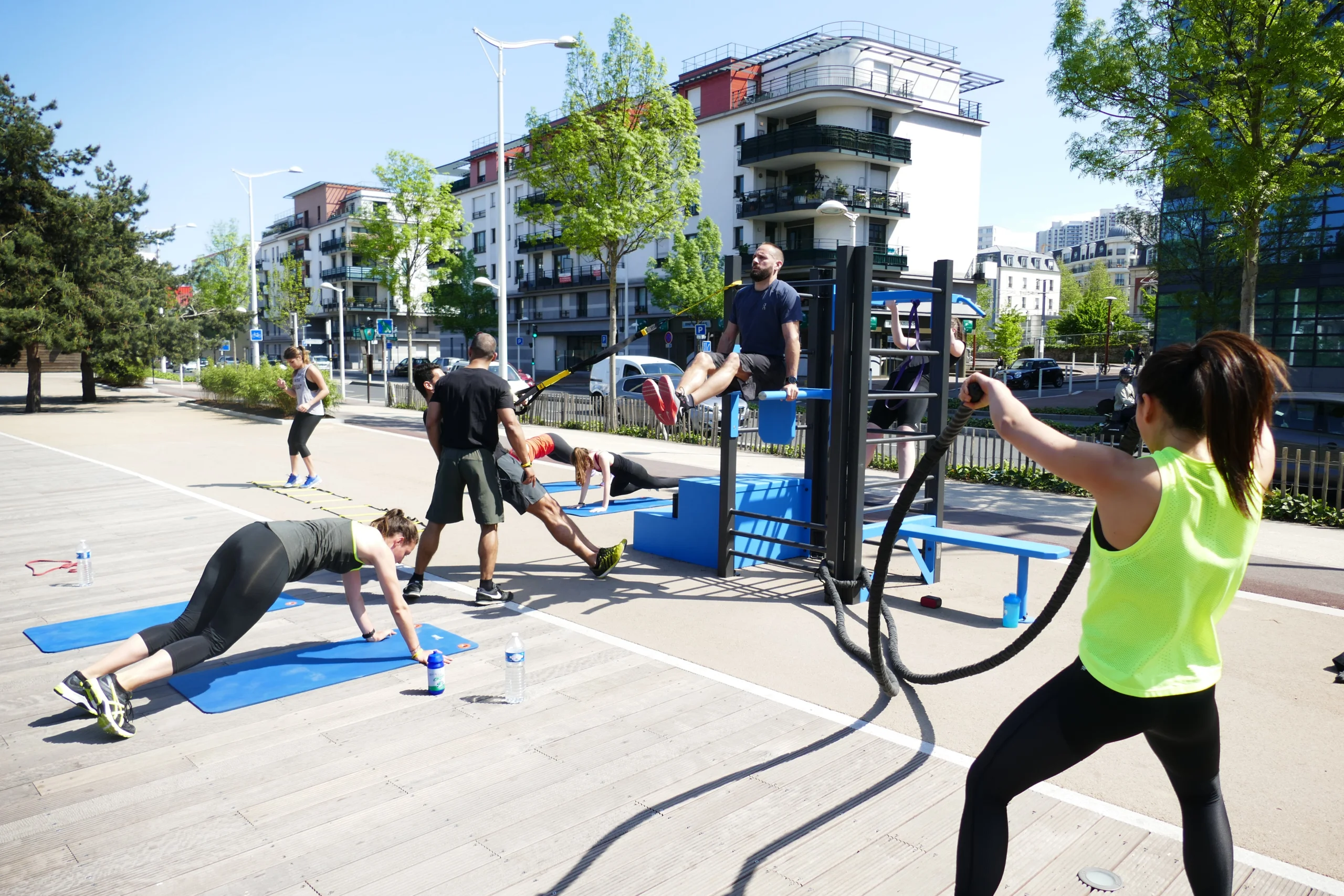Strength Training, Outdoor Fitness
The Ultimate HIIT Circuit for Burning Fat in the Summer Heat: Your Solution to Staying Fit

Introducing HIIT Circuit Training
HIIT (High-Intensity Interval Training) circuit training involves short bursts of high-intensity exercises followed by brief rest periods. This type of workout has been shown to be incredibly effective for burning fat in less time than traditional steady-state cardio workouts.
The beauty of HIIT circuit training is that it’s highly adaptable and customizable based on your fitness level and preferences. You don’t necessarily need equipment or weights; bodyweight exercises like burpees or jump squats are just as effective when done at high intensity.
And because HIIT circuits typically last under 30 minutes, they’re perfect for busy schedules or days when you just don’t feel like spending hours at the gym. Next up in this article – The Benefits of HIIT Circuit Training – we’ll take a closer look at why this type of workout is so effective for burning fat and improving overall fitness.
Table of Contents
The Benefits of HIIT Circuit Training
How HIIT Circuits Work and Why They Are Effective for Burning Fat
HIIT, or high-intensity interval training, is a type of workout that involves short bursts of intense exercise followed by periods of rest or lower intensity. These intense intervals challenge your body to work harder and burn more calories than traditional cardio workouts.
HIIT circuits are a combination of different exercises performed in a specific order and with minimal rest between sets. During a HIIT circuit, your heart rate stays elevated throughout the workout due to the constant movement between exercises.
This increased heart rate causes your body to use stored fat as energy, leading to fat loss and increased muscle tone. Unlike traditional cardio workouts that only target one area of the body at a time, HIIT circuits engage multiple muscle groups simultaneously, resulting in an overall more efficient workout.
The Benefits of HIIT Circuits Compared to Traditional Cardio Workouts
One major benefit of HIIT circuits is their efficiency. A typical workout can be completed in 30 minutes or less, making it ideal for busy schedules. Additionally, research has shown that even after you finish working out, your body continues to burn calories at an elevated rate for up to 24 hours due to the afterburn effect.
Compared to traditional cardio workouts like jogging or cycling, which can lead to muscle loss if done excessively over time, HIIT circuits preserve muscle mass while burning fat. And because these workouts can be customized based on fitness level and goals, they are suitable for beginners and advanced athletes alike.
Another major benefit is variety – by changing up the exercises in each circuit regularly; you can prevent boredom and keep challenging yourself mentally as well as physically. This variety also makes it easy to adapt workouts based on location or equipment availability.
The benefits of incorporating HIIT circuit training into your fitness routine include fat loss, increased muscle tone, efficiency, muscle preservation, and variety. If you have not yet tried a HIIT circuit workout, we encourage you to give it a try and see the results for yourself!

The Ultimate HIIT Circuit for Burning Fat in the Summer Heat
The Exercises: A Detailed Breakdown
Now that you have an idea of what a HIIT circuit is and why it’s so effective for burning fat, let’s dive into the specific exercises that make up our Ultimate HIIT Circuit. These exercises were chosen because they target multiple muscle groups and are high-intensity, meaning they’ll get your heart rate up and keep it there throughout the workout.
Here’s a breakdown of each exercise:
1. Burpees – Start standing, then quickly drop down into a push-up position, do a push-up, jump your feet towards your hands, and jump up with arms overhead. Repeat.
2. Mountain climbers – Begin in a plank position with hands shoulder-width apart. Bring one knee towards the chest then alternate legs.
3. Jump squats – Start in a squatting position with feet shoulder-width apart. Propelling yourself upwards from this position land softly back into the squatting position.
4. High knees – Run on the spot lifting your knees as high as you can while keeping your core tight.
5. Plyometric lunges – Start in lunge pose with one leg forward and one leg back at 90-degree angles of knee flexion with the rear foot elevated slightly off the ground so that ball of the foot is resting on the bench or box behind you or on the wall behind you if outside). Jump straight up landing back in lunge pose but switching legs.
Modifications for Different Fitness Levels
Everyone has different levels of fitness and physical ability, so don’t be discouraged if you can’t complete all of these exercises at first! Here are some modifications to adjust the workout based on your fitness level:
– If burpees are too challenging, try step-backs instead (step back into plank pose instead of jumping)
– For mountain climbers, you can slow down the pace or do them with your hands elevated on a bench or wall instead of on the ground.
– Jump squats can be modified by doing regular squats instead.
– If high knees are too intense, try marching in place instead.
– Plyometric lunges can be modified into static lunges. Just eliminate the jumping motion.
Don’t worry about getting everything perfect on your first attempt. Focus on doing what’s best for your body while also challenging yourself.
Proper Form and Technique: Avoiding Injury and Maximizing Results
While HIIT circuits are highly effective for burning fat, they also put a lot of stress on your body—so it’s crucial to use proper form and technique to prevent injury. Here are some tips for making sure you’re performing each exercise correctly:
– Keep your core engaged at all times throughout each movement.
– Make sure your knees don’t cave inward during exercises like jump squats and plyometric lunges (this could cause knee pain or injuries)
– Use a mat if needed to prevent slipping.
– Pay attention to how you land when jumping.
– Aim for soft landings.
By following these guidelines, you’ll not only prevent injuries but also maximize the results of each exercise. Remember to listen to your body and take breaks if needed!

Tips for Staying Safe and Cool During Summer Workouts
Hydrate, Hydrate, Hydrate!
We all know staying hydrated is critical. Drinking water before, during, and after your workout will help you regulate your body temperature and prevent dehydration.
It’s important to drink water even if you don’t feel thirsty because thirst is often a sign that you’re already dehydrated. Consider bringing a water bottle with you during your workout or planning your route around water fountains.
Dress Appropriately
Wearing the right clothing can make all the difference in staying cool and comfortable during summer workouts. Opt for light-colored, loose-fitting clothing made from breathable materials like cotton or moisture-wicking fabric that helps draw sweat away from your skin. Avoid dark colors that can absorb heat and make you feel hotter.
Protect Your Skin
Summer workouts often mean more exposure to the sun, which can increase your risk of sunburn and skin damage. Be sure to apply sunscreen with at least SPF 30 before heading outside, and reapply every two hours if you’re sweating heavily or swimming. Wear a wide-brimmed hat or visor to protect your face from the sun’s rays.
Avoid Extreme Heat
If it’s particularly hot outside or if there’s an air quality warning in effect, consider modifying your workout routine to avoid extreme heat. Try working out indoors in an air-conditioned gym or home gym instead of outdoors. If you do want to work out outside but want to avoid peak heat hours (usually between noon-4 pm), try working out early in the morning or late in the evening when temperatures are cooler.
By following these tips for staying safe and cool during summer workouts, you’ll be able to enjoy all the benefits of the Ultimate HIIT Circuit for Burning Fat in the Summer Heat without worrying about dehydration, sunburns, or extreme heat. Remember to listen to your body and take breaks as needed, and always prioritize safety over pushing yourself too hard.
Frequently Asked Questions About HIIT Circuit Training
Is HIIT Circuit Training Safe?
While any form of exercise carries some degree of risk, HIIT circuit training is generally considered to be safe for most people. However, it’s important to listen to your body and not push yourself too hard, especially if you’re new to exercise or have any underlying health conditions.
Always consult with your doctor before starting a new workout program. Additionally, proper form and technique are crucial in minimizing the risk of injury during HIIT circuits.
Make sure to use good posture, engage your core muscles, and avoid jerky movements or excessive strain on joints. If you’re unsure about how to perform an exercise safely, consider working with a personal trainer or taking a group fitness class where the instructor can provide guidance and feedback.
How Effective is HIIT Circuit Training for Burning Fat?
Research has shown that HIIT circuits are highly effective for burning fat and improving overall fitness levels. The intensity of the workouts means that you’ll continue burning calories even after your workout is over (known as the “afterburn effect”), helping you reach your weight loss goals faster.
In addition to its fat-burning benefits, HIIT circuit training has been shown to improve cardiovascular health, boost endurance and strength, and enhance postural alignment. Plus, because these workouts are typically shorter than traditional cardio sessions (usually around 30 minutes), they can fit into even the busiest schedules.
How Much Time Commitment Does HIIT Circuit Training Require?
One of the great things about HIIT circuit training is that it can be done in a relatively short amount of time – most workouts last between 20-30 minutes. This makes it an ideal option for those who are short on time but still want an effective workout. That being said, while HIIT circuits may be shorter than traditional cardio workouts, they are also more intense and require a higher level of effort.
To get the most out of these workouts, you’ll need to give it your all during each exercise interval. If you’re new to exercise or have any health concerns, it’s important to start slowly and gradually build up your fitness level over time.
Where Can I Learn More About HIIT Circuit Training?
There are a variety of resources available for those who want to learn more about HIIT circuit training. Many gyms and fitness studios offer classes or personal training sessions that focus on this type of workout.
Additionally, there are plenty of online resources, such as blogs and YouTube channels, that provide tips and guidance for incorporating HIIT circuit training into your fitness routine. Some popular online resources for HIIT circuit training include Bodybuilding.com, Muscleandfitness.com, and Darebee.com.
While there is some risk involved with any form of exercise, taking proper precautions such as using good form and consulting with a doctor before starting can help minimize these risks. With its short duration and high intensity, HIIT circuits can fit into even the busiest schedules – making it a great option for anyone looking to get in shape this summer!
Conclusion
Key Takeaways from the Article
HIIT circuit training is an effective method for burning fat and getting in shape during the summer heat. By combining high-intensity exercises with short rest periods, you can elevate your heart rate and boost your metabolism for hours after your workout.
The Ultimate HIIT Circuit for Burning Fat in the Summer Heat provides a challenging and rewarding workout that targets all major muscle groups while keeping you engaged and motivated. It is important to remember that safety should always come first when working out in hot temperatures.
This means staying hydrated, wearing appropriate clothing, and taking breaks as needed. If you feel lightheaded or dizzy during a workout, stop immediately and seek medical attention if necessary.
Craving for more HIIT? Check out this post about HIIT Tabata.



